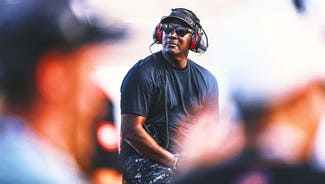
Are drivers scared of big, bad Talladega?
"My family certainly worries whenever we are at Daytona and Talladega,’’ said two-time Daytona 500 winner Michael Waltrip. “But for me, those were always a couple places I knew we could win at.”
For NASCAR Sprint Cup drivers, danger may be an inherent part of their job, but it’s not something they regularly consider. Not even when heading to a place like Talladega Superspeedway, where mayhem reigns in races and where the wrecks are so common they’ve earned their own nickname – “The Big One.”
A place where fans hang on the edge of their seats and hope that drivers emerge from those crushed cars unscathed.
Just look at what Talladega has wrought in recent years alone.
In the two NASCAR Sprint Cup Series races at Talladega Superspeedway last year, 39 different cars were involved in crashes or incidents that brought out caution flags.
In last April’s Aarons 499 alone, 24 cars – more than half the starting field – were caught up in yellow-flag mania. Two Aprils ago, Carl Edwards’ No. 99 Ford was launched airborne in a last-lap accident, smashing violently into the wire fence along the front grandstands. Seven fans were injured by the flying debris, but amazingly Edwards climbed out of the wreckage and was able to jog across the finish line, where he jumped in the air, hands raised to the crowd in a sort of defiant triumph.
Despite its well-deserved reputation as the biggest, baddest, raciest of NASCAR’s venues, Talladega Superspeedway doesn’t intimidate these guys.
“I don’t think racing drivers think about the danger at these race tracks, we’re just thinking what we have to do to win,’’ said Ryan Newman, whose No. 39 U.S. Army Chevy collided with Edwards in that 2009 last-lap crash and was itself launched airborne seven months later in the last lap of the fall Cup race at the 2.66-mile superspeedway.
“Mostly when I pull into Talladega, I’m thinking about when I’m going to get a chance to go fishing.’’
“It’s no different today than the last 40 years. The first person that pulled in there said this is going to be fast and dangerous. But he still raced.’’
Obviously it’s a required mindset when you’re making a living maneuvering a car just inches from another car’s bumper at 200 mph for three hours.
But the tightly bunched pack racing typical of Talladega’s expansive straightaways and towering banking introduced “The Big One’’ into racing crash vocabulary. It is home to NASCAR’s fastest lap ever (Bill Elliott’s 212.809 mph qualifying lap in 1987). And after Bobby Allison’s frightening airborne crash in that 1987 race, it became the very reason carburetor restrictor plates are now used to slow cars at NASCAR’s two big, high-banked tracks.
“It’s weird,’’ Waltrip continued, then paused. “I’ve never thought of getting hurt. Ever. It wouldn’t allow you to do your job right if you laid back and just hoped not to crash.
“But, yes, your family shakes its head and says, ‘Don’t you know what this place can do to you?’‘’
For Waltrip, Newman and the other drivers, this approach is equal parts racing instinct and safety innovation.
While a race car driver’s mindset might not have changed in the four decades NASCAR has been thrilling fans at Talladega, the fact is the cars are exponentially safer and the track walls softer in recent years.
“We all realize this used to be a lot more dangerous,’’ Waltrip said.
The advances in car and track safety haven’t given NASCAR’s current generation of racers a false sense of security, but perhaps a larger comfort zone.
Despite the 10- and 20-car pile-ups and spectacular crashes that characterize Talladega, the last notable serious injury to a Cup driver there was 1996 when the late Dale Earnhardt suffered a broken collarbone in a crash. The last Cup series race fatality at the track was driver Tiny Lund in 1975.
In his postrace winner’s news conference following the 2009 Aaron’s 499, first-time winner Brad Keselowski was careful to stress how grateful he was that Edwards and the fans weren’t seriously injured in that frightening last-lap ending.
But, he also candidly expressed, “There has to be some element of danger into it.
“If we would have ran all race without a single lap of contact, everyone in the media center would have wrote about how boring of a race it was and instead we ran one of the best races you could ever watch on TV with full contact the whole time.’’
Five-time reigning Sprint Cup Series champ Jimmie Johnson said last week he certainly doesn’t get any more worked up arriving at Talladega than he does at smaller tracks.
“We feel like we’re crawling around the track, it’s so big and so wide,’’ said Johnson, whose No. 48 Lowe’s Chevy was one of the few cars not involved in a yellow flag incident in either 2010 Talladega race.
“I guess the big fear that’s in the back of my mind is getting airborne. That thought comes through every now and then, but it doesn’t usually happen until you get turned around.
“Everything up until then, you’re real comfortable. The fact that we can bump and push and do what we do shows how comfortable we are.
“The fear part is pretty far removed,’’ said Johnson. “It’s not that intimidating until things go wrong.’’

